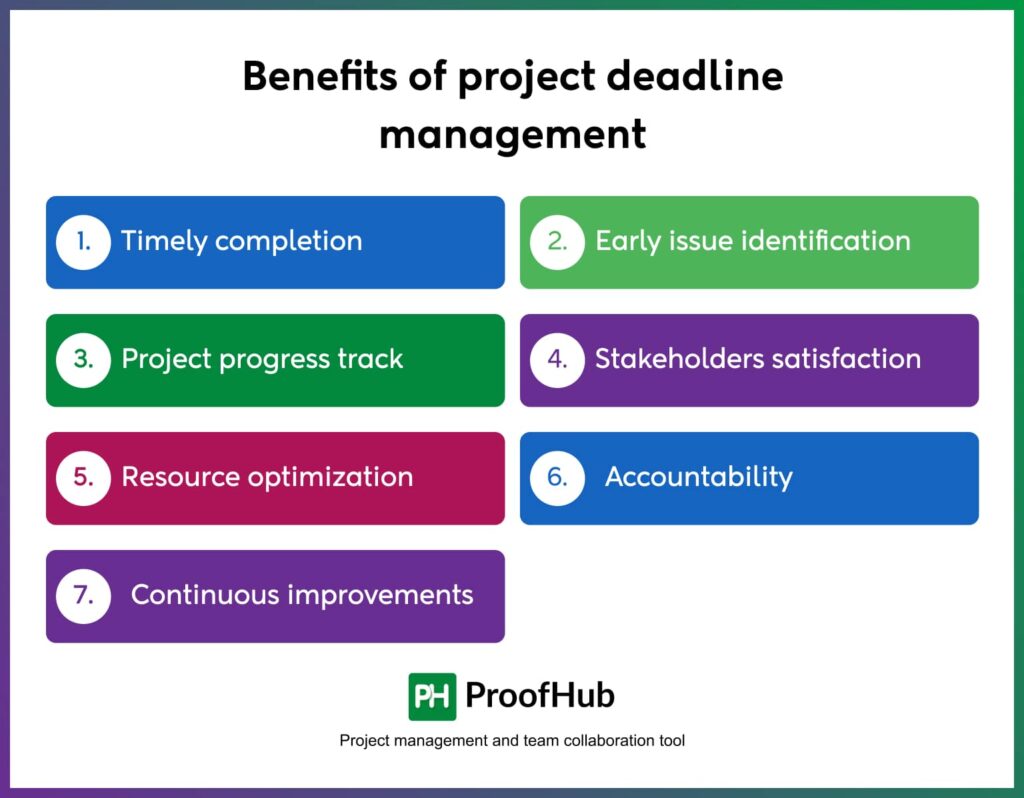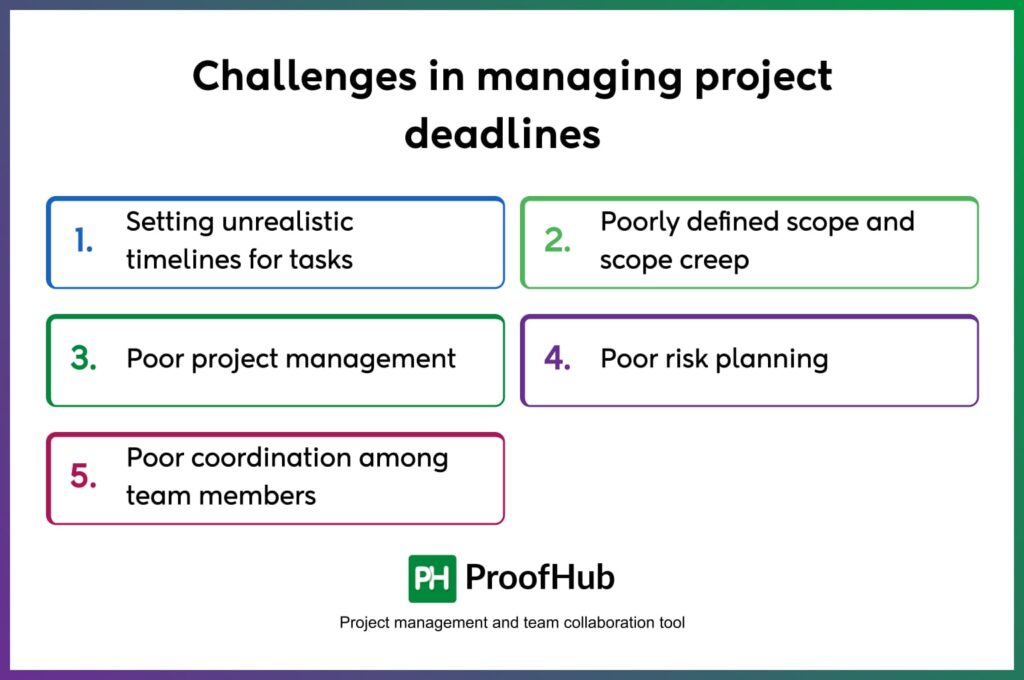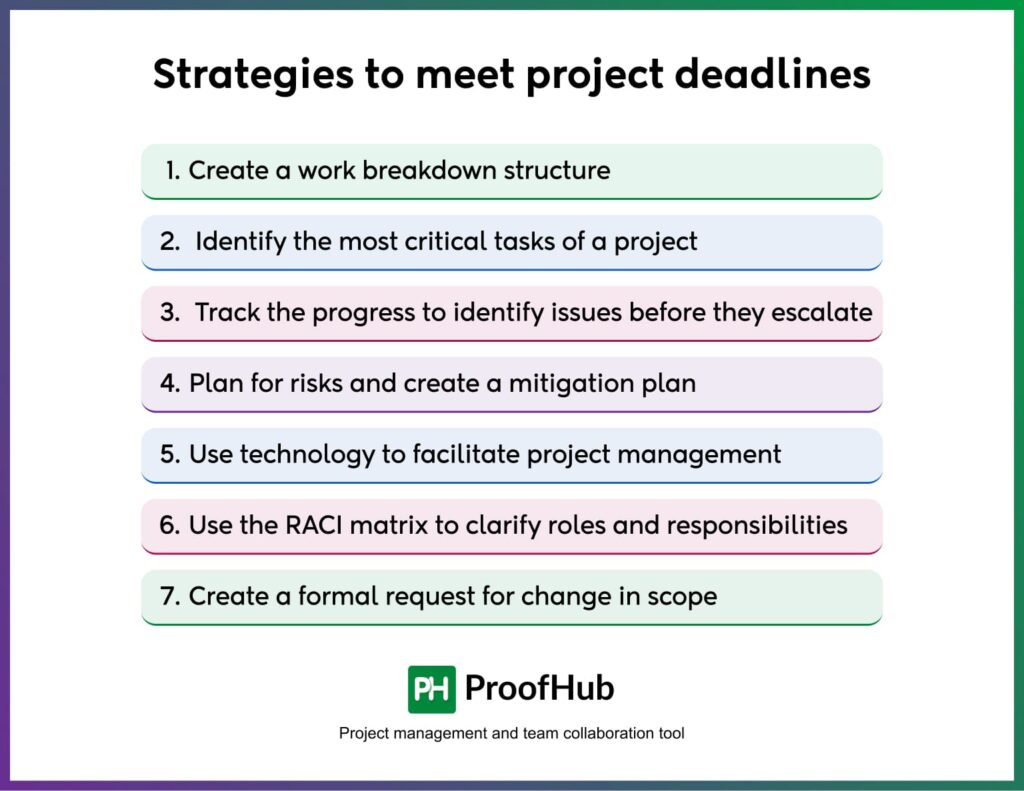Meeting a project deadline is one of the core measures of project success, yet surprisingly, about 30% of projects are completed on time and within budget. Absolute success in a project depends on meeting deadlines and aligning with business requirements, adhering to budget constraints, and delivering business value and return on investment.
This article will discuss project deadline management, an essential skill in ensuring your project meets and exceeds expectations.
We will also discuss the root causes behind missing project deadlines, uncover effective strategies to proactively manage project deadlines to meet them on time, and understand the role of advanced project management software in achieving timely project completion.
A Free guide to help you with proven ways to lead a project from start to finish, without confusion or jargon.

What is a project deadline?
A project deadline is a certain date by which a project must be completed. While a project has one overarching deadline, its phases or milestones may have their deadlines.
Project deadlines are crucial for ensuring project success as they directly impact project quality, budget, and delivery.
For example, inadequate time allocation for project tasks often leads to compromised quality and cost overruns due to delays.
Eventually, all this somewhere hints at how important it is to set a realistic deadline for a project. It helps project managers to plan tasks effectively, estimate time requirements accurately, allocate resources efficiently, and provide clear goals for project teams. Transparent deadlines facilitate stakeholders’ clear view of the project’s progress.
What are the types of project deadlines?
There are several types of project deadlines. Understanding the types of project deadlines helps in managing them effectively. Have a look at them.

- Internal deadlines: These are the deadlines set within the organization by a project manager to ensure the work is completed on time. These are somewhat flexible and can be adjusted as needed.
- External deadlines: These are the deadlines that are set by an external entity such as clients or regulatory bodies. You should meet them at all costs to fulfill contractual obligations.
- Hard or absolute deadlines: These deadlines cannot be modified. If it is missed, there is no value to completing a task.
- Soft or flexible deadlines: These deadlines can be modified. It can be adjusted if needed and a task still has value if it gets completed by a re-adjusted deadline.
- Self-imposed, other-imposed, and agreed-upon deadlines: Self-imposed deadlines are set by an individual to complete the work on time. Others set other-imposed deadlines to get work completed on time without involving the individual’s input. Agreed-upon deadlines are agreed upon mutually by the task assignee and a team member working on the task.
What is project deadline management?
The Standish Group research shows that only 9% of software is completed on time and budget in the larger companies.
Project deadline management is the process of setting the project deadlines right and managing them. It involves tracking the project’s progress, prioritizing tasks, and optimizing resources to ensure that projects are completed on schedule.
While distant from project time management, which focuses on time estimation, deadline management heavily relies on accurate task duration estimates. Key principles of project time management include breaking a project into tasks, creating a detailed work breakdown structure, defining an order for tasks, setting task dependencies, estimating task duration using various techniques, allocating resources for the projects, and deciding on the risk management plan.
Benefits of project deadline management
Project deadline management offers you the following benefits:

- Timely completion: Ensure projects are completed on schedule with clear milestones.
- Early issue identification: Early detection and resolution of potential issues by continuously tracking project progress against the original plan.
- Project progress track: Serves as an early warning system to bring projects back on track
- Stakeholders satisfaction: Fulfill stakeholder’s needs and provide them with transparency in project progress.
- Resource optimization: Efficiently allocates resources based on the project needs
- Accountability: Maintain a sense of responsibility within project teams and promote disciplined project execution.
- Continuous improvements: Providing data-driven insights for future project planning and enhancements.
What are the challenges in managing project deadlines?
There are five main reasons for missing the project deadline. Have a look at them.

1. Setting unrealistic timelines for tasks
This is the major reason for missing project deadlines. When a project manager is not able to calculate the realistic timeline for each task in a project, it leads to underestimation of the project duration.
It can happen due to various reasons such as poorly defined scope and task requirements, lack of skills of a project manager in estimating time for a task, and a project manager trying to create a perfect project plan to make stakeholders happy.
Thus, project team members are not able to complete the tasks in time despite their best efforts.
2. Poorly defined scope and scope creep
This is the second major reason for missing deadlines for a project. When a project manager is not able to gather and clearly understand the requirements of the client and define the acceptance criteria for product feature quality, it results in poorly defined task requirements. This leads to poor time estimation for tasks in the project and project duration.
Poorly defined scope also causes delays because the client is not getting what they hoped for and they want to add new features as it was not mentioned in the scope. Thus, it leads to rework and the expansion of the scope, which results in project delays that often go beyond control.
3. Poor project management
Poor project management practices are a major contributor to missing project deadlines. When a project team does not have a project plan with defined timelines, clear roles and responsibilities, and processes to manage project challenges, it is hard to complete the project within the deadline. A project manager is not able to track the progress and decide the right course of action to get the project back on track.
4. Poor risk planning
Poor risk planning is another major reason for missing project deadlines. A project is subjected to various types of risks related to resources (human, material, and technology), scope, cost, and external environmental factors. In the absence of a risk management plan, you are not able to handle project risks effectively. This causes missing project deadlines and cost overruns.
5. Poor coordination among team members
A study by the Project Management Institute (PMI) states that poor communication is a contributing factor in 56% of the projects that failed.
A project can fail to meet the deadline despite the perfect project plan and time estimations if your project team is poor in communication and coordination. It can happen due to various reasons such as lack of commitment from team members, disputes within the team, and lack of technology such as a work management platform for the team to communicate effectively.
You need to address all these challenges to complete a project on time.
7 Effective strategies to meet project deadlines
Based on my years of experience managing multiple projects and teams and knowledge gained from experts, I have shortlisted a few practices that can help you meet project deadlines. You can strategize your project deadline management using these practices.

1. Create a work breakdown structure and estimate the time correctly
“Running a project without a work breakdown structure is like going to a strange land without a road map” – J. Phillips
Breaking down a project into smaller tasks using a Work Breakdown Structure (WBS) is fundamental for accurate time estimation. This structured approach involves organizing tasks hierarchically, ensuring each subtask is clearly defined. This method is effective with a well-defined scope. For projects lacking clarity, alternative techniques like historical analysis or the Critical Path Method are essential for precise time estimates.
Read more: Ultimate guide on project scheduling: Know everything about it
2. Identify the most critical tasks of a project
“The key is not to prioritize what’s on your schedule, but to schedule your priorities.” – Stephen Covey
Project deadline management does not end with setting the right timeline for each task. You have to manage the tasks throughout the project execution phase to make sure a project runs on schedule. Prioritizing tasks and understanding dependencies are crucial for managing project deadlines. Managers can allocate buffer time and resources to mitigate risks and ensure deadlines are met by identifying critical tasks and their potential impacts on project duration.
3. Track the progress to identify issues before they escalate
“A deadline is negative inspiration. Still, it’s better than no inspiration at all.” – Rita Mae Brown
It is hard to keep the project on track and meet the deadlines if you are not tracking the progress of the project. Regular progress tracking is vital to keep – the project on schedule. Discrepancies can be promptly addressed by comparing actual progress to the original plan. This will help you identify and manage issues before they become big enough to impact the project.
One of the common questions new managers often ask is how frequently we should track and review the progress of a project and when they should take action. Well, the right answer is it depends from project to project.
The tracking frequency depends on project methodology—daily for Agile and weekly for Waterfall—ensuring timely intervention to prevent delays.
4. Plan for risks and create a mitigation plan
No project comes without risks. This is because you need to assume many things to create a project plan. The only solution to handle these uncertainties is to have a detailed risk mitigation plan in place.
Establishing a risk register and assigning severity levels helps prioritize risks. Once done, allocating buffer time and contingency funds- adjusted based on project complexity ensures resilience against unforeseen challenges.
As a general rule of thumb, you should allocate 15-20% of the original time as the buffer time and the same percentage of the original funds as the contingency funds. However, it should be changed as per the project’s complexity, risks, and nature and can vary from 10 to 25%.
Read more: Project assumptions: a guide to identify, evaluate & manage risks
5. Use technology to facilitate project management and team collaboration
Effective project management software enhances planning, execution, and collaboration, crucial for meeting deadlines. It also facilitates collaboration in teams so that they can work together easily and effectively as per the project plan to meet deadlines. By consolidating project data and enabling seamless- team communication and task management, such tools ensure better control over project timelines. –
You can use spreadsheets for keeping track of the project tasks and emails for team communication and task delegation, but these tools are not effective in managing project deadlines for complex projects and large teams.
6. Use the RACI matrix to clarify roles and responsibilities
Suppose your projects fail due to poor team coordination and unclear roles and responsibilities. In that case, the RACI matrix is the best tool for assigning duties and streamlining communication. RACI is an acronym for responsible, accountable, consulted, and informed. It defines whether a team member is responsible, accountable, consulted, or informed for any task. This clarity minimizes confusion and improves accountability, fostering efficient project execution.
7. Create a formal request for change in scope and manage stakeholder expectations
Key project stakeholders have a great influence and interest in the project. Fulfilling the expectations of stakeholders is the responsibility of a project manager. But at the same time, it gets hard for a project manager to fulfill expectations every time without expanding the budget and extending the project deadline.
Create a formal process to raise requests for changes in scope. It is because often little change requests pile up to become a reason for missing project deadlines. With an office channel to raise requests for scope changes, stakeholders are aware of the impact of changes in scope on the deadline and project’s budget.
Also, projects rarely go perfectly according to plan. You may need to get approval from stakeholders to deal with challenges. Active stakeholder management and keeping them involved in decision-making help you get approvals for adjustments in the project deadline and schedule.
I hope using these strategies you can complete your project on time and meet deadlines within budget.
Manage project deadlines with ProofHub
ProofHub is an all-in-one project management and team collaboration software that helps you meet deadlines for every project with its sophisticated system of features. You can create a plan for a project, break a project into tasks, and create an order of tasks to complete every step of the project.
With ProofHub, you can visualize all the tasks of a project on a Gantt chart. This helps you see the entire project roadmap, milestones on the way, and dependencies between tasks. Thus, you can easily identify the most important tasks of a project and visualize the impact of a delay of one task on the project deadline.
With features like project reports, you can get a complete overview of the progress of the task in real time. If you want to manage tasks and shift task deadlines, you have the luxury of viewing all tasks with their key details on a Kanban board and scheduling the resource on a Calendar.
Having all the team documents directly attached to the tasks, you can easily collaborate with the team right from the tasks using task comments. This avoids confusion, ensures accountability, and streamlines & organizes communication.
You can plan your project today in ProofHub with a 14-day free trial. This will give you an idea of how ProofHub can help you with project deadline management.
Conclusion
Meeting project deadlines is a challenging yet crucial aspect of project management. It is hard to find a project manager who says my team easily meets all the deadlines. In the real world, you often have to adjust your deadlines. Having said that, it does not mean deadlines are not useful.
No active project deadline management will only make things worse. Thus, to increase your chances of meeting project deadlines, it is important to invest time, effort, and energy in project deadline management. In the long run, it will reap the benefits many times worthy of your investment.
With the right understanding and strategies for project deadline management and project management software in place, you can ensure your team meets the deadline for every project.
FAQs
What should I do if a deadline is missed?
The first thing you need to do is to inform the concerned reporting person as soon as you find that a deadline is missed or you are about to miss the deadline. This will provide them with an early start to assess the impact, react to the delay better, and set a new deadline for the task after receiving inputs from you.
How to set a project deadline?
There are various time estimation techniques that you can use to set the deadline for a project. The most popular time estimation techniques include the Critical path method, PERT, Top-down estimating, Bottom-up estimating, Three-point estimating, Historical data analysis, and Subject matter expert time estimation. Keep in mind the concept of planning fallacy while setting the deadline because it leads to too optimistic or pessimistic time estimates for a task.
What role do milestones play in project deadline management?
Setting milestones increases the chance of meeting project deadlines by making it easy to track the large end goals by breaking them into short goals. Thus, you have a clear idea of how much work should be completed by a certain date in the project. If it is not achieved, you still have the time to cover for the delay in the coming milestones. Thus, it leads to effective project deadline management.

